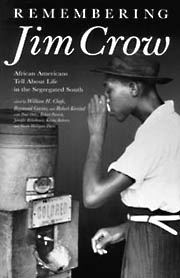|
 
|
October 29, 2001
Daily horrors of the Jim Crow era recorded in oral history project
By Jennifer McNulty
For historians, few projects offer the professional or personal satisfaction that
comes with gathering and preserving little-known stories. And so Paul Ortiz, an assistant
professor of community studies, feels particularly honored to have been part of a
major project to record the oral histories of African Americans who lived under Jim
Crow in the segregated South.
 |
| Paul Ortiz, an assistant professor of community studies, was research coordinator
for the oral history project and conducted dozens of the field interviews. |
The highlights of those oral histories have been compiled in the important new book
Remembering Jim Crow: African Americans Tell about Life in the Segregated South
(New York: New Press, 2001).
The book, illustrated with 50 rare segregation-era photographs, is accompanied
by two CDs: One contains excerpts of the original interviews and the second is a
major radio documentary produced by American RadioWorks that will air on many National
Public Radio stations on November 13.
The book's firsthand accounts of living under Jim Crow convey the hardship and suffering
experienced by African Americans in the United States from the end of the 19th century
into the 1960s.
Participants describe the daily horrors of lynching, harassment, and sexual exploitation,
and they reveal the resourcefulness with which they fought back, building communities
at home, at work, and in the church to resist oppression and lay the groundwork for
broad social change.
Ortiz, who was research coordinator for the project and conducted dozens of the field
interviews as a graduate student at Duke University, edited two of the six chapters
of the book, "Heritage and Memory" and "Work." Other chapters
address "Bitter Truths, "Families and Communities," "Lessons
Well Learned," and "Resistance and Political Struggles." The publication
is a project of the Behind the Veil Project of Duke's Center for Documentary Studies.
Ortiz found particular inspiration in the stories of Leon Alexander and Earl Brown,
both of whom organized coal miners in Alabama in the 1930s in a struggle to unionize
for better wages and working conditions--a goal that encompassed getting white miners
to join the union, too.
"We know how tough Birmingham was in the civil rights era," said Ortiz,
who studies social movements. "Imagine how tough it was in the 1930s. These
men fought the system without any national attention or support or anything we associate
with the civil rights movement of the 1960s."
Interview subjects were eager to relate their life experiences--after Ortiz and his
fellow interviewers built trust.
"These senior citizens are at a point in their lives where they really want
to tell their stories," said Ortiz. "They share a sense that they made
history, and they feel they can educate the younger generations."
Researchers gained the trust of participants in part by explaining their intention
to contribute a full set of tapes and printed materials to community repositories
in regions where they conducted interviews. More than 1,200 interviews were recorded
between 1993 and 1995.
"There is a renaissance of public history around the country, and community
historians were very helpful to us," said Ortiz. "We wanted to link the
academic and community components of the project."
Jim Crow was one of the longest periods of American history, yet historians have
done a poor job of documenting the actual experiences of black Americans during the
age of segregation, according to Ortiz. Unlike slavery, which had a definitive end,
and the civil rights era, which marked a period of "positive and uplifting progress,"
the segregation that was pervasive under Jim Crow lingers today, said Ortiz.
"I can't go before a class of sixth graders and tell them segregation is over,"
he said. "They would laugh."
Oral history is an exciting and challenging tool for historians, said Ortiz, in part
because interviews invariably wander into unexpected territory.
"I remember talking with Tolbert Chism about Native American, African American,
and white interrelationships, and he started talking about the Trail of Tears,"
recalled Ortiz, referring to the forced removal in the 1830s of Native Americans
from the East Coast to the Oklahoma Territory in which thousands died. "I nearly
dropped my notebook. He traced his heritage back to the Trail of Tears."
Accounts of racial violence and sexual exploitation were "incredibly painful"
to hear about, but Ortiz said the saddest aspect of the project for him personally
was the "vivid descriptions of everyday racial oppression--the sense of being
in a system that's not of your own making and being kept trapped at the bottom of
society."
The struggles of black farmers in south Florida were anguishing, he said, as they
were thwarted in their repeated attempts to gain ground by planting their own crops,
buying land, and sending their children to school. "The whites would burn the
crop, shoot the farmers, and shut the schools at harvest time," said Ortiz.
"It's the cumulative oppression that gives you the sense of anguish."
And yet the book is hopeful, too, in a way that reflects the full range of human
experience. Out of their oppression, individuals came together and formed unions,
church groups, and fraternal organizations that have endured and are still thriving
today. They learned, as Ortiz put it, "how to build a democratic society in
an antidemocratic society."
"Without half the advantages we have today, these people decided not to accept
the status quo," marveled Ortiz. "People will read this and begin to feel
a deeper appreciation for the role ordinary people can have in affecting social change."
The book was edited by William Chafe, Raymond Gavins, and Robert Korstad with Ortiz,
Robert Parrish, Jennifer Ritterhouse, Keisha Roberts, and Nicole Waligora-Davis.

|
 |